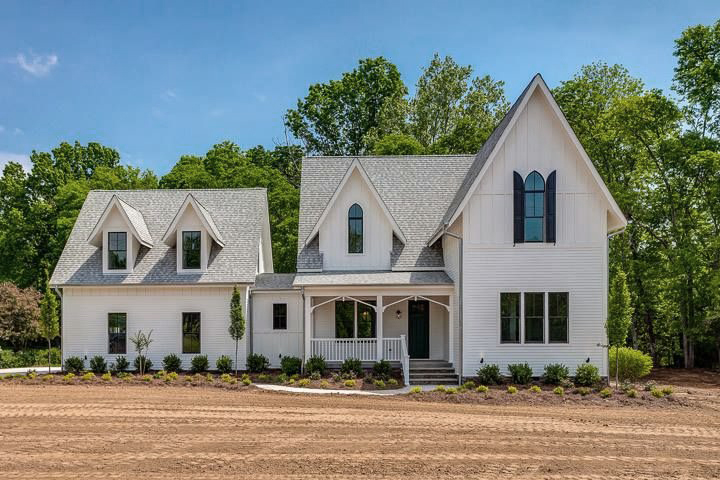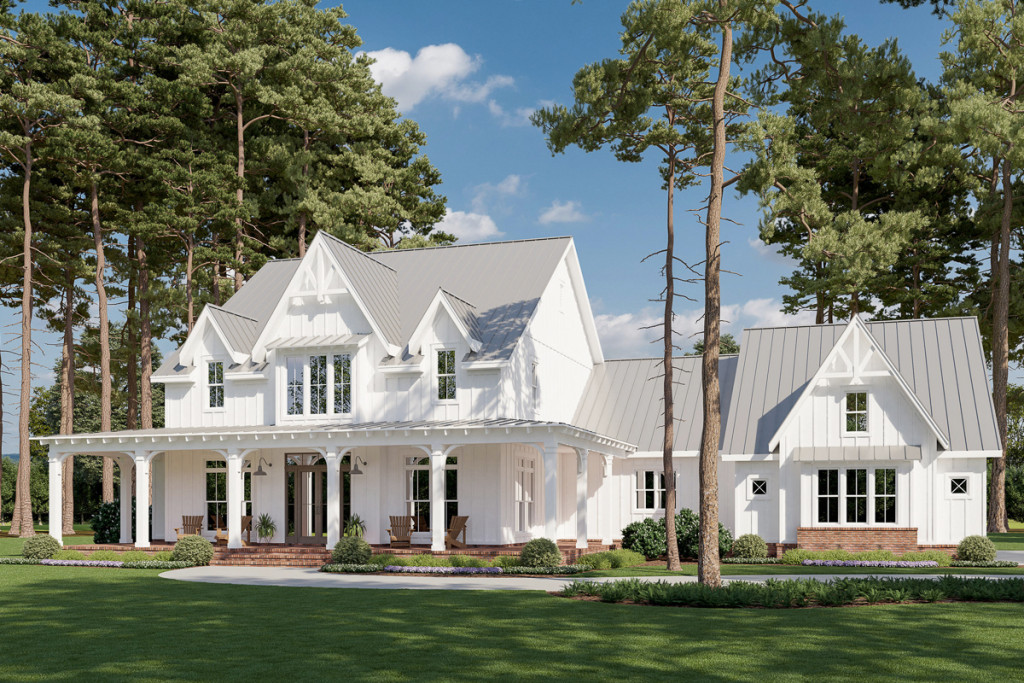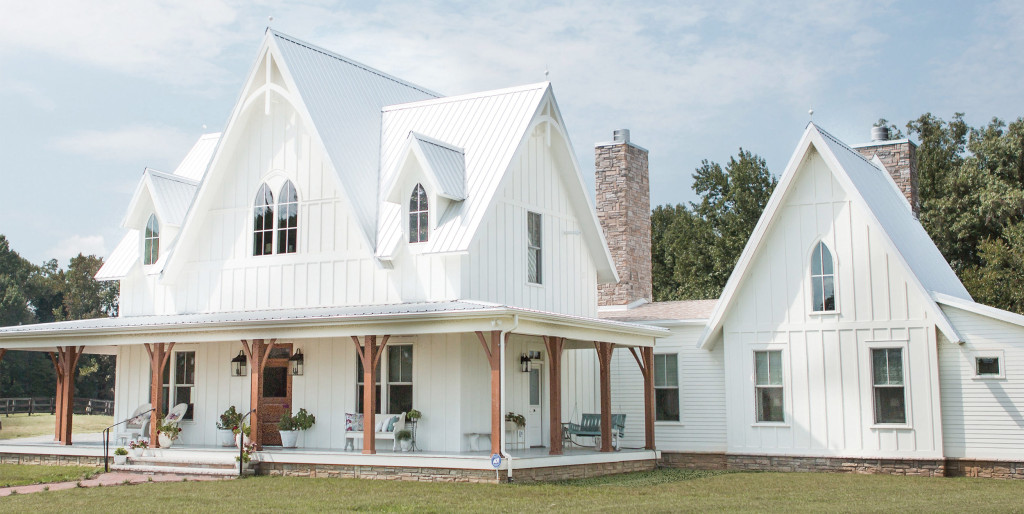Introduction
The Allure of Gothic Farmhouses
Gothic farmhouses hold an undeniable allure, their enigmatic elegance captivating the imagination. These unique dwellings blend the rustic charm of farmhouse living with the soaring artistry of Gothic architecture, creating a captivating atmosphere that is both inviting and awe-inspiring.
The Historical Significance
Gothic farmhouses arose in the nineteenth 100 years, during the Gothic Restoration time frame. Propelled by the middle age Gothic houses of God of Europe, American modelers started integrating Gothic components into their plans, including pointed curves, supports, and stained glass windows. These components were frequently joined with customary farmhouse highlights, for example, wraparound patios and animal dwellingplace like designs.
Modern-Day Revival
In recent years, there has been a renewed interest in Gothic farmhouses, as homeowners are drawn to their unique character and historical significance. Many Gothic farmhouses are now being meticulously restored, preserving their original charm while also updating them for modern living.

Architectural Marvels
Pointed Arches and Buttresses
One of the most unmistakable elements of Gothic design is the utilization of pointed curves and braces. Pointed curves are taller and more thin than round curves, making a feeling of level and magnificence.Buttresses are external supports that help to reinforce the walls of Gothic buildings. In Gothic farmhouses, pointed arches and buttresses are often used to accentuate doorways, windows, and porches.
Exquisite Stained Glass Windows
Stained glass windows are another hallmark of Gothic architecture. These windows are made up of colored pieces of glass that are arranged to create intricate designs and biblical scenes. In Gothic farmhouses, stained glass windows are often used to adorn the front porch or living room, adding a touch of elegance and spirituality to the home.
Towering Spires and Turrets
Gothic farmhouses are often topped with towering spires and turrets. These components add a feeling of show and secret to the home, making it stand apart from its environmental factors. Towers and turrets likewise fill a functional need, assisting with ventilating the loft and offer extra help for the rooftop.
Detailed Tracery Work
Tracery work is a decorative technique that involves carving intricate patterns into stone or wood. Tracery work is often used to adorn the windows, doorways, and porches of Gothic farmhouses. These intricate patterns add a touch of sophistication and beauty to the home.
Mysterious Gargoyles
Beasts are abnormal stone figures that are in many cases put on the outside of Gothic structures. Figures of deformity are said to avert detestable spirits and safeguard the structure from hurt. In Gothic farmhouses, foreboding figures are much of the time put on the edges of the rooftop or over entryways.
Setting the Scene
Rural Locations
They are in many cases settled in country settings, encompassed by moving slopes, lavish fields, and murmuring backwoods. This ideal scenery improves the home’s ethereal magnificence and makes a feeling of harmony and serenity.
Landscaping and Gardens
Many Gothic farmhouses feature carefully manicured lawns, lush flower gardens, and towering shade trees. These landscaping elements complement the home’s architectural features and create a welcoming and inviting atmosphere.
Spooky or Scenic Surroundings
Some Gothic farmhouses are situated in spooky or scenic surroundings, such as on a hilltop overlooking a misty valley or near an abandoned graveyard. These atmospheric settings add to the home’s mystique and allure.
Interior Grandeur
Vaulted Ceilings
Vaulted ceilings are a common feature of Gothic farmhouses. These high, arched ceilings create a sense of spaciousness and grandeur. Vaulted ceilings are often adorned with exposed beams or intricate plasterwork, adding to the home’s visual appeal.
Ornate Woodwork
Ornate woodwork is another hallmark of Gothic farmhouses. This woodwork can be found throughout the home, from the staircase to the fireplace mantle to the kitchen cabinets. Gothic woodwork is often characterized by its intricate carvings and decorative motifs.
Fireplace Focal Points
The fireplace is often the focal point of a Gothic farmhouse’s living room.Gothic chimneys are ordinarily huge and forcing, with intricate mantelpieces and hearths. These chimneys give a warm and welcoming space for loved ones to accumulate.
Intricate Flooring
Intricate flooring is another common feature of Gothic farmhouses. This deck can be made of wood, stone, or tile, and is in many cases organized in unpredictable examples. Gothic ground surface adds a bit of extravagance and refinement to the home.
Gothic Farmhouse Styles
Victorian Gothic
Victorian Gothic farmhouses were worked during the Victorian period, which endured from the mid-nineteenth hundred years to the mid twentieth hundred years. These farmhouses are portrayed by their resplendent and elaborate plans, exhibiting the building and configuration patterns of the period.
Victorian Gothic farmhouses are much of the time enormous and forcing, with numerous accounts, gabled rooftops, and wraparound patios. These homes are additionally known for their unpredictable woodwork, finished glass windows, and enhancing equipment.
Revivalist Styles
Gothic Recovery farmhouses were implicit the late nineteenth and mid twentieth hundreds of years, during a time of reestablished interest in Gothic engineering. These farmhouses frequently integrate components of Victorian Gothic plan, however they are additionally affected by other engineering styles, like Artistic expression and Specialties development.
Evangelist Gothic farmhouses are regularly less resplendent than Victorian Gothic farmhouses, yet they actually hold the fundamental components of Gothic engineering, like pointed curves, supports, and stained glass windows.
Modern Gothic
Modern Gothic farmhouses are a more recent development. These homes incorporate elements of traditional Gothic architecture, such as pointed arches and gabled roofs, with more modern design elements, such as clean lines and open floor plans.
Modern Gothic farmhouses are often built with sustainable materials and feature energy-efficient features. These homes offer the best of both worlds, combining the historic charm of Gothic architecture with the modern amenities and conveniences that homeowners desire.

Haunting History
Legends and Myths
Gothic farmhouses are often shrouded in mystery and intrigue. Many of these homes are associated with legends and myths, such as ghostly encounters and supernatural phenomena.
One of the most famous legends associated with Gothic farmhouses is the story of the White Lady of Lemp Mansion. This manor is situated in St. Louis, Missouri, and is supposed to be spooky by the phantom of Julia Lemp, a young lady who took her own life in the manor in 1904.
Famous Gothic Farmhouses
There are numerous popular Gothic farmhouses situated all through the US. The absolute most notable models include:
- The Lemp Chateau in St. Louis, Missouri
- The Lizzie Borden House in Fall Stream, Massachusetts
- The Amityville Ghastliness House in Amityville, New York
- The Winchester Mystery House in San Jose, California
These homes have been highlighted in various books, motion pictures, and TV programs, further solidifying their status as notable Gothic milestones.
Literary Inspirations
Gothic farmhouses have also inspired many writers and poets. Some of the most famous literary works that feature Gothic farmhouses include:
- The Turn of the Screw by Henry James
- Dracula by Bram Stoker
- The Haunting of Hill House by Shirley Jackson
- Frankenstein by Mary Shelley
These works of fiction have helped to shape the public’s perception of Gothic farmhouses as mysterious and atmospheric places.
Gothic Farmhouses in Pop Culture
Movies and TV Shows
Gothic farmhouses have been featured in many popular movies and TV shows, including:
- The Shining (1980)
- Amityville Horror (1979)
- The Conjuring (2013)
- Annabelle (2014)
- The Haunting of Hill House (2018)
These films and TV shows have helped to popularize the Gothic farmhouse aesthetic and have made these homes even more desirable to potential buyers.
Literature and Art
Gothic farmhouses have likewise been a well known subject of writing and craftsmanship. Probably the most renowned models include:
- The Fall of the Place of Usher by Edgar Allan Poe
- The Picture of Dorian Gray by Oscar Wilde
- The Addams Family by Charles Addams
- The Nightmare Before Christmas by Tim Burton
These works of literature and art have helped to create a romantic and atmospheric image of the Gothic farmhouse.
Music and Symbolism
Gothic farmhouses have also been referenced in music and symbolism. For example, the Gothic farmhouse is often used as a symbol of mystery and the supernatural in gothic rock and metal music. Additionally, the Gothic farmhouse is sometimes used in advertising and marketing to create a sense of suspense or intrigue.
Conclusion
Gothic farmhouses are truly unique and special homes. They offer a remarkable mix of natural appeal and Gothic class.
On the off chance that you are thinking about purchasing or remodeling a Gothic farmhouse, make certain to investigate as needs be and work with a certified planner or worker for hire. With cautious preparation and execution, you can make a home that is both agreeable and in vogue.
FAQs
What are the characteristics of a Gothic style house?
Gothic style houses are characterized by their pointed arches, buttresses, stained glass windows, and gabled roofs. They may also have turrets, gargoyles, and other decorative elements.
What are Gothic houses made of?
Gothic houses are typically made of stone or brick. However, some Gothic Revival farmhouses may be made of wood.
Where did the Gothic house come from?
Gothic architecture originated in France in the 12th century. It spread all through Europe and ultimately advanced toward the US in the nineteenth 100 years.
Why is Gothic architecture so beautiful?
Gothic architecture is often admired for its soaring heights, delicate tracery work, and intricate stained glass windows. Gothic architects were also masters of light and shadow, which they used to create dramatic effects in their buildings.
How to decorate a Gothic farmhouse?
While embellishing a Gothic farmhouse, choosing furniture and goods that supplement the home’s structural style is significant. Antique furnishings, for example, four-banner beds, armoires, and pendulum timekeepers, can assist with making a heartfelt and environmental feel. Be that as it may, it is critical to blend and coordinate antique furniture with additional cutting edge pieces to make an agreeable and welcoming space.
Profound gem tones, for example, emerald green, sapphire blue, and ruby red, can assist with making a sensational and refined thoroughly search in a Gothic farmhouse. Be that as it may, it is vital to adjust these striking tones with lighter shades, like cream, white, and beige, to make a feeling of equilibrium and congruity.
While picking materials and textures for a Gothic farmhouse, it is essential to choose materials that are sumptuous and extravagant. Velvet, silk, and damask are fantastic decisions for curtains, shades, and upholstery. You can likewise add a hint of caprice with Gothic-enlivened prints and examples, like bats, bugs, and foreboding figures.
How to renovate a Gothic farmhouse?
Renovating a Gothic farmhouse can be a challenging endeavor. These homes are in many cases old and needing critical fixes. Moreover, the remarkable elements of Gothic engineering, like pointed curves and stained glass windows, can be troublesome and costly to reestablish.
In any case, with cautious preparation and execution, it is feasible to revamp a Gothic farmhouse while protecting its unique appeal and character.
Here are some tips for renovating a Gothic farmhouse:
- Work with a qualified architect or contractor who has experience in renovating historic homes.
- Research the historical backdrop of your home and recognize any unique highlights that you need to protect.
- Utilize excellent materials and development methods to guarantee that your redesign is strong and dependable.
- Be patient and understanding. Renovating a Gothic farmhouse takes time and money, but the results will be worth it.

